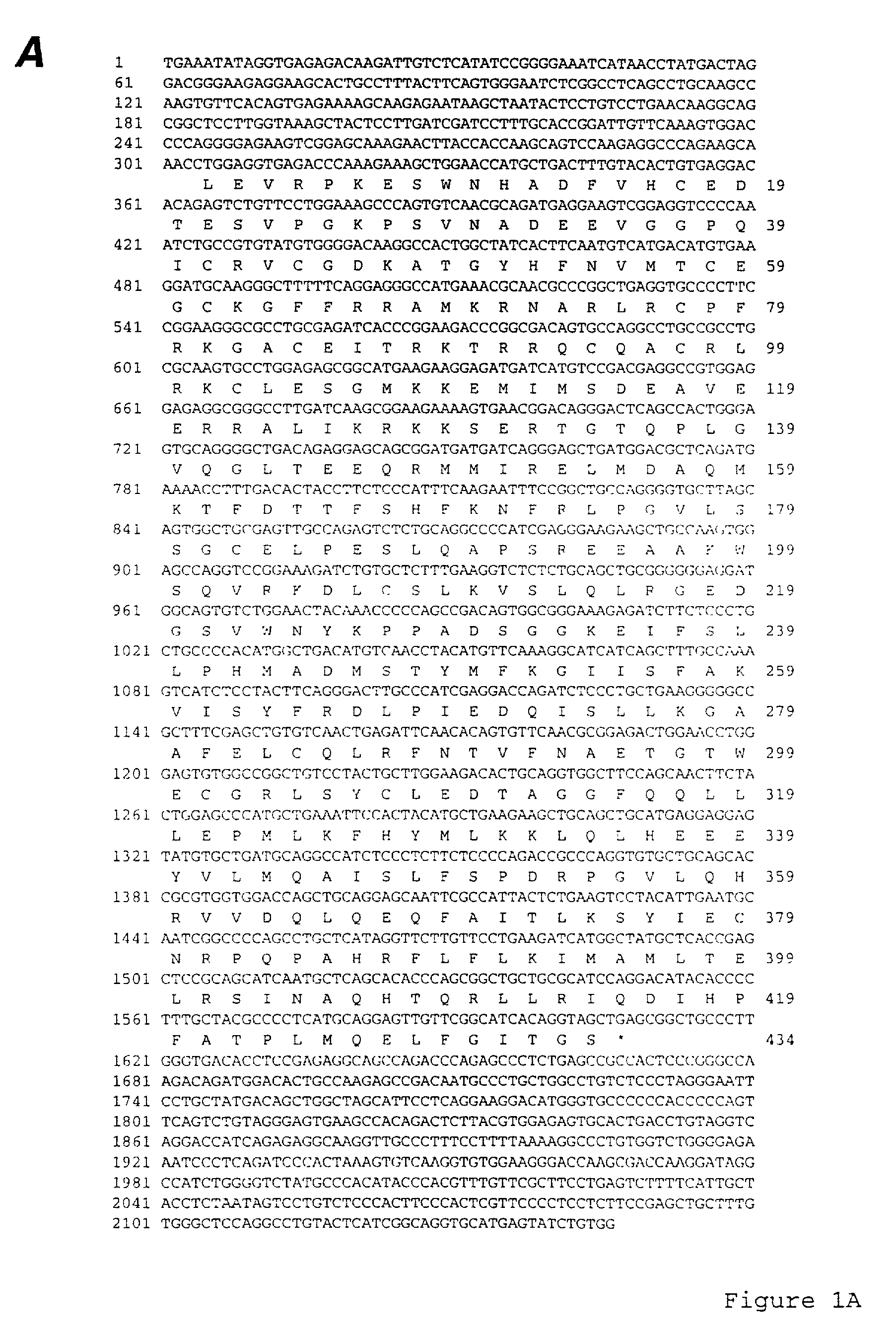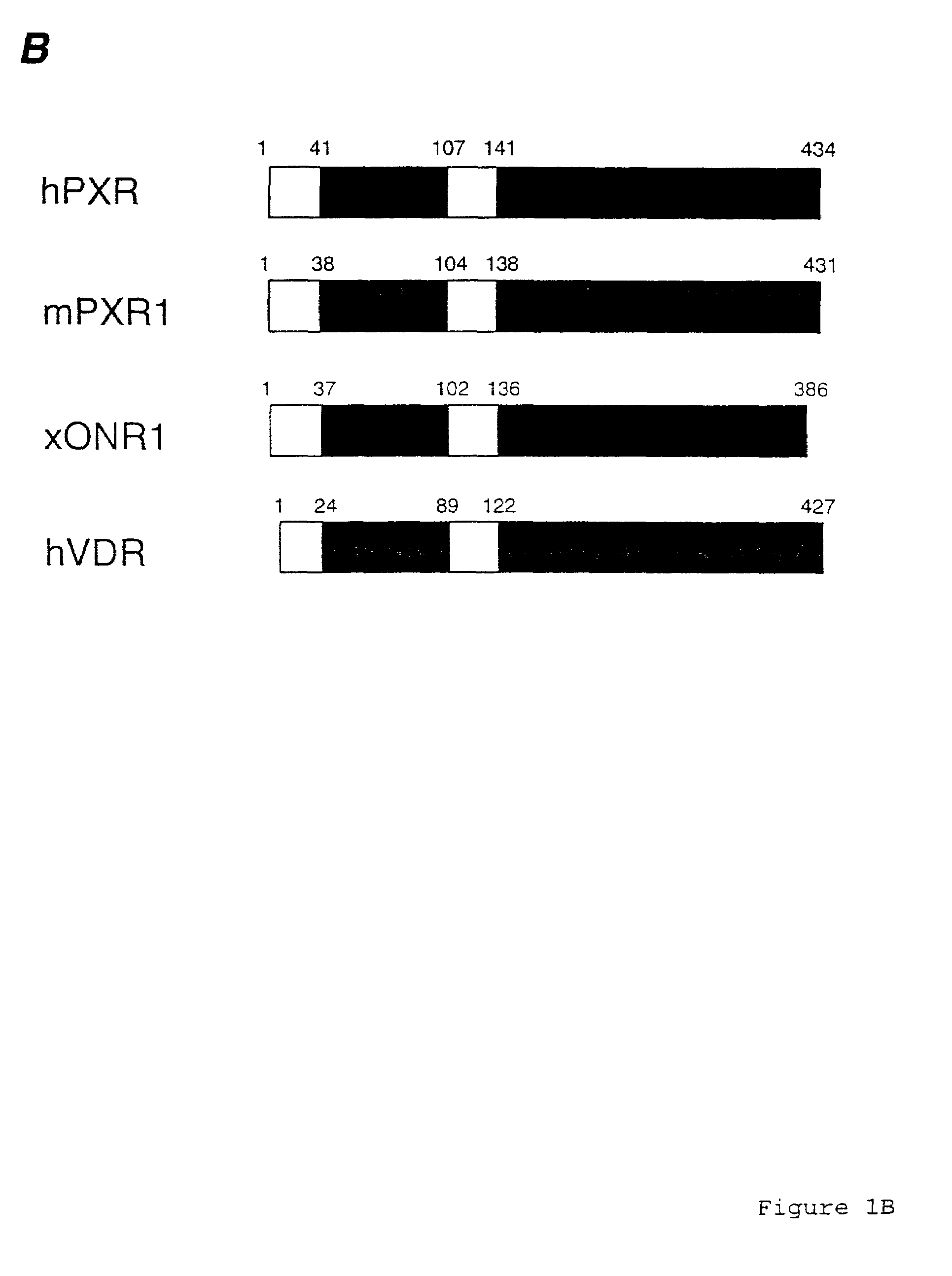Pregnane X receptor method
a technology of x receptor and pregnancy, which is applied in the field of new human orphan nuclear receptor, can solve the problems of limited utility of using animals and their tissues for testing purposes, and hampered efforts
- Summary
- Abstract
- Description
- Claims
- Application Information
AI Technical Summary
Benefits of technology
Problems solved by technology
Method used
Image
Examples
example 1
Molecular Cloning and Tissue Expression Pattern of hPXR
[0048]A human EST was identified in the Incyte LifeSeq® proprietary database that was highly homologous to a region of mPXR1 (Kliewer et al, Cell 92:73–82 (1998)). Two larger clones were isolated in a screen of a human liver cDNA library using an oligonucleotide within the EST as a probe. The longest of these clones was 2146 bp in length (FIG. 1A) and encoded a new member of the nuclear receptor superfamily that was 97% and 76% identical to mPXR1 in the DNA binding domain (DBD) and ligand binding domain (LBD), respectively (FIG. 1B). In terms of other members of the nuclear receptor superfamily, hPXR was most closely related to the Xenopus laevis orphan receptor ONR1 (Smith et al, Nucl. Acids Res. 22:66–71 (1994)) and the vitamin D receptor (FIG. 1B). Notably, the hPXR sequence lacked an AUG initiator codon in between an in-frame stop codon (nucleotides 205–207 in the hPXR sequence) and the start of the region encoding the DBD. ...
example 2
hPXR Activates Transcription Through a Response Element in the CYP3A4 Gene Promoter
[0051]Several lines of evidence have been provided that mPXR1 regulates CYP3A1 gene expression: mPXR1 was activated by compounds known to activate CYP3A1 gene expression including glucocorticoids and antiglucocorticoids, mPXR1 and CYP3A1 gene expression colocalized in the liver and small intestine, and mPXR1 bound to a response element in the CYP3A1 gene promoter that had previously been determined to confer responsiveness to glucocorticoids and antiglucocorticoids (Kliewer et al, Cell 92:73–82 (1998), Quattrochi et al, J. Biol. Chem. 270:28917–28923 (1995), Huss et al, J. Biol. Chem. 93:4666–4670 (1996)). The findings that the CYP3A4 gene is also expressed in the liver and intestine and that this expression is induced in response to glucocorticoids and antiglucocorticoids (Molawa et al, Proc. Natl. Acad. Sci. USA 83:5311–5315 (1986), Kocarek et al, Drug Met. Dispos. 23:415–421 (1995)) led to the inve...
example 3
Differential Activation of Human and mPXR
[0054]CYP3A4 gene expression is induced in response to a remarkable array of xenobiotics, including synthetic steroids (Kocarek et al, Drug Met. Dispos. 23:415–421 (1995), Schuetz et al, J. Biol. Chem. 259:2007–2012 (1984), Heuman et al, Mol. Pharmacol. 21:753–760 (1982), Schulte-Hermann et al, Cancer Res. 48:2462–2468 (1988)), macrolide antibiotics (Wrighton et al, Biochem. 24:2171–2178 (1985)), antimycotics (Hostetler et al, Mol. Pharmacol. 35:279–285 (1989)), HMG-CoA reductase inhibitors (statins) (Kocarek et al, Toxicol. Appl. Pharmacol. 120:298–307 (1993), Schuetz et al., Hepatology 18:1254–1262 (1993)), and phenobarbital-like compounds (Heuman et al, Mol. Pharmacol. 21:753–760 (1982)). It was next determined whether hPXR might mediate the effects of some or all of these compounds on CYP3A4 expression. CV-1 cells were cotransfected with the pSG5-hPXR ATG expression plasmid and the (IR6)3-tk-CAT reporter plasmid, and the cells were treate...
PUM
 Login to View More
Login to View More Abstract
Description
Claims
Application Information
 Login to View More
Login to View More - Generate Ideas
- Intellectual Property
- Life Sciences
- Materials
- Tech Scout
- Unparalleled Data Quality
- Higher Quality Content
- 60% Fewer Hallucinations
Browse by: Latest US Patents, China's latest patents, Technical Efficacy Thesaurus, Application Domain, Technology Topic, Popular Technical Reports.
© 2025 PatSnap. All rights reserved.Legal|Privacy policy|Modern Slavery Act Transparency Statement|Sitemap|About US| Contact US: help@patsnap.com



